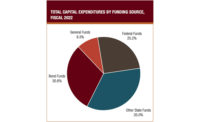The construction industry posted a healthy 2014, as total spending rose 5.6% to $961.4 billion the Commerce Dept. has reported. The total was the highest in six years, a construction economist said.
In its latest monthly construction spending report, released on Feb. 2, Commerce’s U.S. Census Bureau also said that the seasonally adjusted value of completed work edged up 0.4% in December compared with the previous month, to an annualized rate of $982.1 billion.
Within the full-year 2014 total, which isn’t adjusted for seasonal variations, private construction put in place was up 7.2%, to $687 billion, and public construction climbed a modest 1.8%, to $274.4 billion.
Among private-sector categories, residential—by far the largest segment—gained 3.8% last year, to $355.2 billion.
Private power projects also were up, rising 11.6%, to $101.2 billion; commercial buildings increased 11.9% to $57.1 billion and offices jumped 18.9% to $44.7 billion.
On the down side, private health care construction declined 6.2%, to $38.9 billion and communication was off 7.1%, to $16.1 billion.
In the public sector, large segments showing gains included highways and streets, up 4.1%, to $84.4 billion, and education, which rose 1.2%, to $62 billion.
But public water supply, power, safety and commercial work all dipped for the year.
Ken Simonson, Associated General Contractors of America chief economist, said, “For the first time in nearly a decade there was growth in all three major construction segments—public, private nonresidential and residential.” He noted that the 2014 total spending was the highest since 2008.
Simonson observed that the segments recording the largest annual percentage gains were warehouses, up 50%, and multifamily housing, up 34%. “Both of these categories should do well again in 2015,” he added.
Anirban Basu, Associated Builders and Contractors chief economist, noted that nonresidential construction was up 0.4% in December, from November’s level.
He said, “Despite the slight expansion [from December], nonresidential construction lost some of its momentum during the final two months of 2014; however, this should represent only a minor dip in the industry’s momentum headed into 2015.”
Construction Spending Climbs 5.6% in 2014



Post a comment to this article
Report Abusive Comment